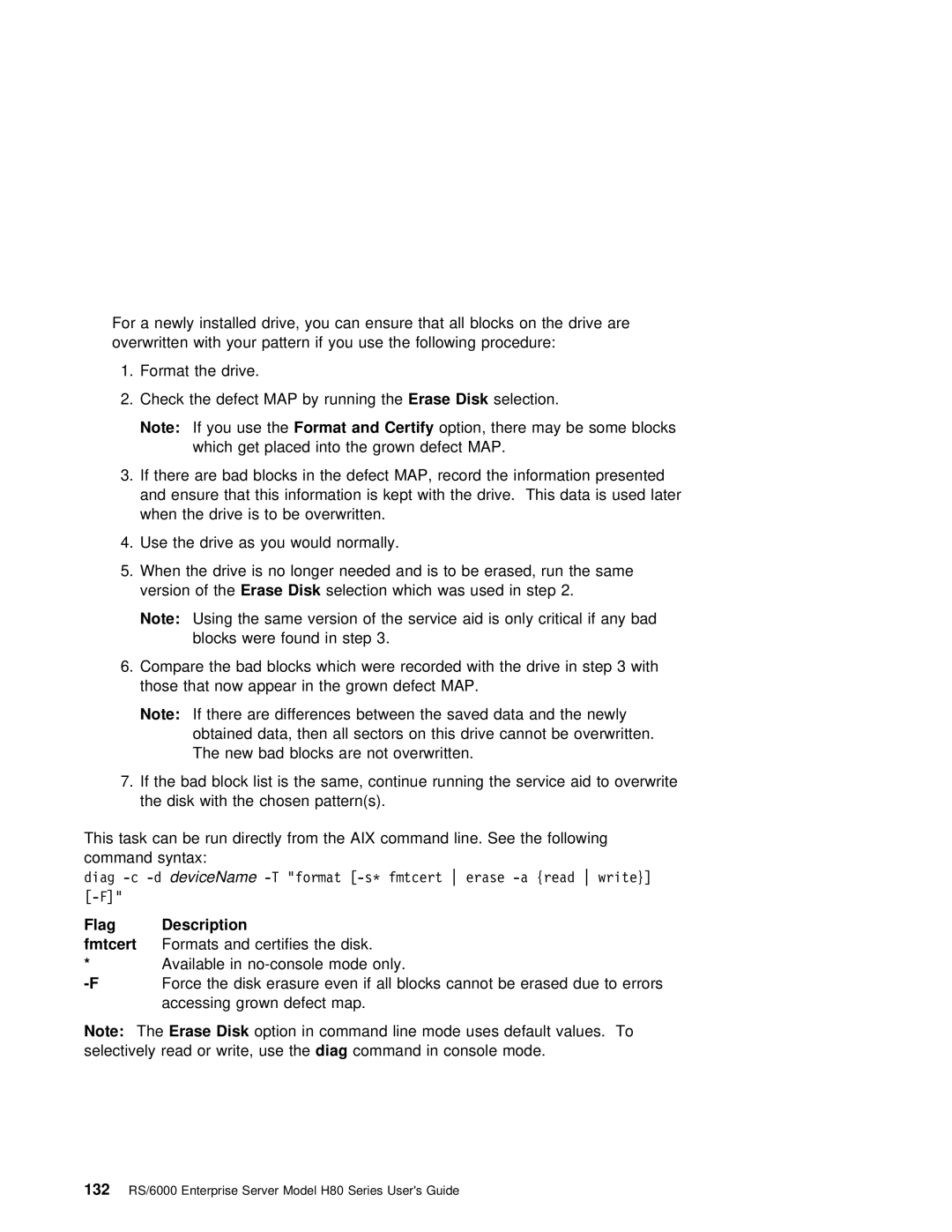For a newly installed drive, you can ensure that all blocks on the drive are overwritten with your pattern if you use the following procedure:
1.Format the drive.
2.Check the defect MAP by runningErase Diskthe selection.
Note: | If | you useFormat theand Certify | option, | there | may | be some | blocks |
| |||||
| which | get placed into the | grown | defect | MAP. |
|
|
| |||||
3. If | there | are | bad | blocks | in | the | defect MAP, record the | information | presented | ||||
and | ensure | that | this | information | is | kept with | the | drive. This data is | used later | ||||
when | the | drive | is to | be | overwritten. |
|
|
|
|
| |||
4. Use the drive as you would normally.
5. When | the | drive is no longer |
| needed and is to be | erased, run | the | same |
| ||||||||||||||||||||
| version | of Erasethe Disk |
| selection |
| which | was | used | in | step | 2. |
|
|
|
|
|
|
| ||||||||||
| Note: | Using | the | same | version |
| of | the | service | aid | is | only | critical | if | any | bad | ||||||||||||
|
| blocks | were | found | in | step | 3. |
|
|
|
|
|
|
|
|
|
|
|
|
|
| |||||||
6. Compare | the | bad | blocks | which | were | recorded | with the drive in step 3 with | |||||||||||||||||||||
| those | that | now | appear | in | the grown | defect MAP. |
|
|
|
|
|
|
|
|
|
| |||||||||||
| Note: If there are differences between the saved data and the newly |
| ||||||||||||||||||||||||||
|
| obtained |
| data, | then | all | sectors | on this | drive | cannot be | overwritten. |
| ||||||||||||||||
|
| The | new | bad | blocks | are | not | overwritten. |
|
|
|
|
|
|
|
|
|
|
| |||||||||
7. If | the | bad | block | list | is | the | same, |
| continue | running | the | service | aid | to | overwrite | |||||||||||||
| the disk with the chosen | pattern(s). |
|
|
|
|
|
|
|
|
|
|
|
|
| |||||||||||||
This task can be run directly from | the | AIX | command | line. | See | the | following |
|
|
| ||||||||||||||||||
command | syntax: |
|
|
|
|
|
|
|
|
|
|
|
|
|
|
|
|
|
|
|
|
|
|
|
|
| ||
diag |
|
|
|
|
|
|
|
|
| |||||||||||||||||||
|
|
|
|
|
|
|
|
|
|
|
|
|
|
|
|
|
|
|
|
|
|
|
|
|
|
|
| |
Flag | Description |
|
|
|
|
|
|
|
|
|
|
|
|
|
|
|
|
|
|
|
|
|
|
|
|
| ||
fmtcert | Formats | and | certifies | the |
| disk. |
|
|
|
|
|
|
|
|
|
|
|
|
|
| ||||||||
* | Available | in | mode | only. |
|
|
|
|
|
|
|
|
|
|
|
|
|
| ||||||||||
Force the disk erasure even if all blocks | cannot be | erased | due | to | errors | |||||||||||||||||||||||
| accessing | grown | defect | map. |
|
|
|
|
|
|
|
|
|
|
|
|
|
|
| |||||||||
Note: The Erase Disk option in command line mode uses default values. To
selectively read or write,diag usecommandthein console mode.
132 RS/6000 Enterprise Server Model H80 Series User's Guide
